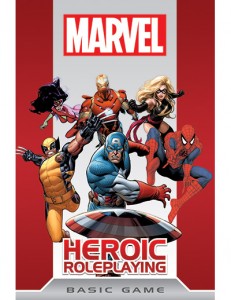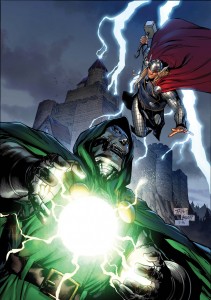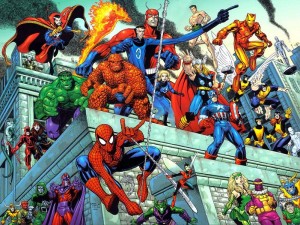Make Mine Marvel
 My players and I are between D&D Campaigns. I’ve got the opening scenes laid out in my head, but I’m just not ready for that pivotal first session. Knowing what I had on hand, I gave my players three choices: I could run their characters in our side campaign through some purchased adventures (D&D 4e), we could try the quickstart rules for DragonAge (closer to D&D), or we could try the new Marvel Heroic Roleplaying. To my surprise, the group that didn’t even want to try Pathfinder, chose Marvel!
My players and I are between D&D Campaigns. I’ve got the opening scenes laid out in my head, but I’m just not ready for that pivotal first session. Knowing what I had on hand, I gave my players three choices: I could run their characters in our side campaign through some purchased adventures (D&D 4e), we could try the quickstart rules for DragonAge (closer to D&D), or we could try the new Marvel Heroic Roleplaying. To my surprise, the group that didn’t even want to try Pathfinder, chose Marvel!
I’m not going to walk you through every element of the game in this review. A number of people have done a great job of that. Check out Exploring Infinity’s excellent Marvel Page for an ever growing list of articles, if you need a little more context.
I’m going to hit some of the highlights and possible pit traps in this article. Maybe this will inspire you to run it. I hope it will, because it’s really a blast. My players are eager for new sessions beyond what was included in the basic game.
The Good
1. Gridless Done Right. There are no maps to speak of in this book. Even though Marvel has a line of miniatures, they made no attempts to even suggest using them. This is a blessing. None of the heroes are reduced in ability to try to make the game seem more balanced. With heroes like Iron man, or the Sentry, the party could quickly be in remarkably different locations and the game handles it with ease. It even encourages you to split the party and bring them back together. It mimics the action of comics quite well, while leaving you unrestrained by a 30 by 24 grid. If you’re curious how this is possible, its because nobody has a measurable movement speed. Distance is measured in narrative with bonuses for creative awesome (also called Stunts and Complications).
2. Accessible Setting and Characters. When playing a Marvel Video game where Cyclops, Captain America and the Hulk all need to stand side by side, you may wonder why they all seem to be doing similar amounts of damage. It’s all for game balance of course. Marvel Heroic Roleplaying does not weaken their most powerful characters so that everyone is starting equal at “Level 1”.
This makes the characters all the more accessible, because if you know what Thor can do in the movies or comics, you already have a great grasp of what he can do in game and can get started describing the action in Epic detail. The balance comes in by allowing characters to add more dice to their roll for thinking creatively and interacting with the narrative.
 3. Doom. Not the Doctor, but the Dice. Marvel uses a great system where the Watcher (the GM) slowly builds more dice as the heroes roll 1s (providing opportunities), make use of abilities that have negative sides (like rage), or when other bad things happen. The dice build right in plain view of the table and really does add a creeping “oh no” factor to play. The Watcher can, in turn, use these to powerful effect in his own rolls, or end a scene that’s gone on a bit longer than is useful/fun.
3. Doom. Not the Doctor, but the Dice. Marvel uses a great system where the Watcher (the GM) slowly builds more dice as the heroes roll 1s (providing opportunities), make use of abilities that have negative sides (like rage), or when other bad things happen. The dice build right in plain view of the table and really does add a creeping “oh no” factor to play. The Watcher can, in turn, use these to powerful effect in his own rolls, or end a scene that’s gone on a bit longer than is useful/fun.
4. Milestones. You don’t get XP for killings things and taking their stuff. You get XP for achieving your character’s roleplaying goals, even if its negative.
The Less Good
1. Assets, Stunts, Resources, Complications etc. Every game comes with its own baggage of jargon. However some of Marvel’s is really similar and are all based on the same mechanic. You need to read the rules, reference and play to really get a handle on things. I think its worth it. One of the most fun parts of the game is that the players have the ability to narratively change the scene. They may be activating a security system, breaking a wall or hijacking a plane, but to an extent they wield the power of the DM, because those elements don’t need to exist before the players establish them. It doesn’t work if you don’t understand your options. This post, also at Exploring Infinity, does an excellent job describing resources in terms of vehicles. I recommend you read it.
2. You have to read the whole thing. This may seem really obvious, but often we don’t do this. We read through the beginning to make sure we have the basic concepts down, and then we go play. I did this for my first session, and we still had fun, but I improvised a bit to make up for it. There are plenty of areas in the book that return to things it covered earlier in part, but then make it clearer or more distinct. You should read all the rules before running the game. If you’re going to run the included event, read the whole thing first. Don’t just skim it. Remember movement is very flexible, and the designers know this. The included event is not linear. There’s no encounter 1 and then encounter 2.
I found myself having more villains than I needed for each Act, which ensured I could be flexible with the story my players were helping to tell, but for the first session I wish I had a better handle on the resources I had available.
 One final note. There was also a little confusion on how to buy the book. The date on Amazon changed while it didn’t change equally on the Margaret Weis website. You can get it now for 20 bucks at the main site. Save a few bucks from Amazon but you’ll have to wait until April 10th. The PDF is available at an even lower price. I went with the PDF and managed to run things just fine, however I probably will end up closer to even after my printed character sheets, and if I print the included event for PAXEast.
One final note. There was also a little confusion on how to buy the book. The date on Amazon changed while it didn’t change equally on the Margaret Weis website. You can get it now for 20 bucks at the main site. Save a few bucks from Amazon but you’ll have to wait until April 10th. The PDF is available at an even lower price. I went with the PDF and managed to run things just fine, however I probably will end up closer to even after my printed character sheets, and if I print the included event for PAXEast.
Speaking of which, if you’re not sold, come find me at the Convention. I plan to be running it. See a future post for more info on my PAX Schedule.
I think it’s clear from this review that I like the game very much. Its real A-level material.
I can’t close this article without plugging a great new site, Plot Points by Dice Monkey. I’ve already made great use of his sliding time table in my own planning, and new content is being produced every day. Show him your love.

The next time I go to a convention I’m going to try to get into a Marvel game. Can anyone sum up the dice mechanic in three sentences or less?
Build a pool of dice from as many categories as possible. Roll them and choose two for your TOTAL (to hit roll or skill check) and one for your EFFECT DIE (damage or strength of what you’re doing), setting aside 1s. The EFFECT DIE SIZE matters, not the roll on that die.
That’s a pretty good summary Mr. Senator.
I love you if only for showing me where I can get a physical copy. I want to run this game sooo much.
Also, good luck at the con!
Thanks for mentioning Plot Points, Brian!
Plot points is my go-to site for Marvel!